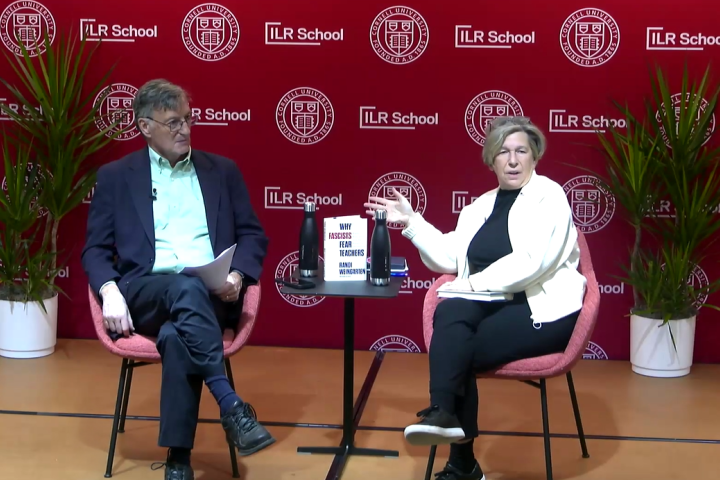
Nursing Homes are Workplaces Too!
John August is the Director of Healthcare Labor Relations at the Scheinman Institute
In 1982, I met Teresa Malafarina and Sherry McHale in Ashland, PA, in the heart of the old anthracite coal regions. They were part of a proud community known for building the early industrial base of the nation, a region known for the earliest successful industrial union struggles in our history.
It was natural for them to call my union, District 1199P for assistance to organize their nursing home. Both had worked at the same facility for close to 20 years as certified nursing assistants.
Why did they want to organize a union?
In their 20 years of service they saw a decline in the staffing, supplies, and in their overall ability to provide high quality care. They attributed the decline to an ownership change of the facility from a local family to a large, multinational corporation. While their pay was low, that was not their primary reason for calling the union. As they told me at the time, “we don’t even have enough of a supply of washcloths that are decent enough to bathe our residents. That is the last straw.” They wanted a union because they believed it would provide a vehicle to be able to say something about how to improve the care for “their family.”
Yes, they saw the residents as their family, which makes sense since the very existence of nursing homes suggests that residents’ families either cannot or will not care for them. This is a common definition of a nursing home as a workplace, or put another way, 3 million people work in 23,000 nursing homes caring for 1.5 million people who want and deserve to be treated as family.
Overwhelmingly the nursing home workforce is made up of poor women of color. Tragically, even today the median hourly rate of pay for a certified nursing assistant, the largest occupation in nursing homes is $14.25/hour. (BLS, 2019) The living wage requirement for a worker with one child is double that amount or around $30/hour depending on where in the nation one lives. (MIT Wage Calculator, 2020) As a result, nursing homes face high turnover rates, which negatively impacts high quality care. Worse, most certified nursing assistants are forced to rush from one patient to the next to provide basic care of feeding and bathing, while licensed practical nurses supervise their work while also providing medications and treatments that they are licensed to provide.
And to make ends meet, many certified nursing assistants work two jobs. This has been true for many years. I recall in 2001, organizing nursing home workers in Glendale, CA and learning that the best place to meet them was at bus stops in the afternoon, as the workers streamed out of their facilities to catch a bus to go to their next job.
For many decades, the quality of care in nursing homes has been very poor. There have been several national reports on the quality of nursing home care, and consistently it is officially reported that 2/3 of nursing home residents receive substandard or abusive care.
Recently and just prior to the COVID-19 pandemic, “In regular surveys conducted from January 2019 through March 2020, nearly half of facilities received an infection control deficiency. Most facilities (80%) received a deficiency related to resident quality of life or care, and 37% received an abuse/neglect/exploitation deficiency. Just under 20% of facilities received a CMP (civil monetary penalty) with the average amount just over $25,000. During this same time period, 62% of facilities had substantiated complaints regarding violations of federal requirements, and 39% of facilities had incidents with alleged or suspected resident abuse, neglect, or misappropriation of property.” (Kaiser Family Foundation Reports, 2020)
And going back further we learn from “The State of Quality Assurance in Nursing Homes Before OBRA 87”, concern about poor quality of care and ineffective regulation of nursing facilities which dates back at least to the 1970s if not earlier. (New York State Moreland Act Commission on Nursing Homes and Residential Facilities, 1975; U.S. Senate Special Committee on Aging, 1974; Wiener, 1981). Scandals and exposés about poor-quality care, abuse, and fraud in nursing homes were depressingly common. (Nursing Home Quality, 20 Years After the Omnibus Budget Reconciliation Act of 1987, Report, December 2007, Kaiser Family Foundation)
Today, as we have all lived through the COVID-19 pandemic the worst of our fears have come true when it comes to nursing homes:
According to the AARP’s report in October, 2020, “Older people are at higher risk for COVID-19, the disease caused by the new coronavirus. So are people with chronic medical conditions such as heart disease, diabetes, kidney disease and respiratory illness. Both groups are heavily represented among the nation's 1.3 million nursing home residents.
That concentration is a key reason why 2 in 5 U.S. deaths from COVID-19 have occurred in nursing homes and other long-term care facilities, according to tracking by the Kaiser Family Foundation, but it's not the only one. Certain conditions at nursing homes can exacerbate the spread of the disease:
- shortages of coronavirus tests
- shortages of or lack of access to personal protective equipment (PPE) such as masks and gowns
- frequent physical contact between residents and staff
- understaffing
- employees who work in multiple facilities, increasing chances for exposure
- residents sharing rooms
In some states, nursing home deaths account for as many as 80% of all the deaths from the pandemic. For example, in Pennsylvania 68% of all COVID-19 deaths occurred in nursing homes.
Hundreds of nursing home workers have died from Covid-19.
We are seeing a renewed focus on the decades’ long failures in the nation’s nursing homes due to the high proportion of nursing home cases and deaths due to Covid-19. Will anything change? What can we expect?
Given the long standing failures as cited above before and during the pandemic, I do not think there is much hope for positive change in the short term.
The state of nursing homes has not changed much from the time I met Teresa and Sherry in 1982. We also know that the workforce continues as a huge low wage/high turnover labor market!
And as the Center for Medicare Advocacy has stated: “The single factor most critical to high quality care and quality of life for nursing home residents is the staff.”
“Fewer people are available to take direct care positions. We must call for a new public investment with greater accountability and ensure money is directed to the frontline”.
There is much more to discuss as to the underlying causes of nursing home failures. The for-profit segment of the industry has grown over the decades to 70% of the industry according to Professor Emerita Charlene Harrington of UCSF. Sicker and more complex patients require more care than in the past, and with 62% of funding for nursing homes coming from Medicaid, all types of ownership models are under pressure. Government and not-for-profit facilities have shrunk as a percentage of ownership due to these pressures, ceding much of the industry and care for this vulnerable population to for-profit investors.
In the face of all of these challenges, there are of course success stories.
I had the good fortune recently to interview leaders of Long Term Care in New York City Health + Hospitals. (NYC H+H), the nation’s largest public health system. The system operates 2200 long term care beds in five facilities across the five boroughs of New York City.
These facilities have maintained their Medicare 5-Star (Highest) Rating since 2003, including throughout the months of the pandemic! The CMS (Medicare and Medicaid) 5-Star Ratings measure and report on the quality of all nursing homes in the United States. The 5-Star ratings measure outcomes of health inspections, staffing, and Quality Measures such as the number of facility acquired infections, patient falls, feeding tube effectiveness, cleanliness, etc.
We know that testing and tracing are central to controlling the spread of the coronavirus. Testing of employees was not mandated until May, 2020, and while testing had been underway, nothing on the scale of testing all employees twice a week had ever been attempted before. Sadly we know that many infections in nursing homes were carried by employees.
The facilities met with their staffs and engaged in open and joint problem-solving to address the complex job of rapidly testing so many employees. Through a series of PDSA (Plan-Do-Study-Act) cycles, the facilities designed testing to maximize results and recording of information:
· Daily calls to track the testing and results
· Refined their process for ordering tests
· Shortened turnaround times for results
· Generated a testing registry reconciliation
· Needed to train agency staff who replaced many regular staff who had to quarantine
· Trained LPNs and Patient Care technicians to administer tests as opposed to only have RNs administer tests
The results of this work and many in depth efforts at continuous quality improvement show that the NYC H+H long term care facilities have had 48 deaths per 1000 residents due to COVID-19 compared to a national average of 219.3 deaths per 1000 residents. And as stated earlier, this was accomplished while maintaining overall 5-Star ratings on performance.
The facilities are publicly owned and operated. The workplaces of NYC H+H Long Term Care are 100% unionized as is the rest of the system of more than 20,000 employees. There is a long history of building a culture of quality which includes formal structures for quality improvement at all five nursing homes, which includes representatives of the CEO, Chief Medical and Nursing Officers as well as direct care staff.
The Doctors Council which is the union for all 2200 attending physicians in the NYC H+H system has developed the Collaboration Councils in all 21 facilities. These Councils which meet monthly as an agreed upon process through collective bargaining have established additional forums for joint evaluation of issues and initiatives to improve quality outcomes for patients.
For example, at Sea View, the largest of the five facilities of Long Term Care, the Collaboration Council supported an initiative to improve flu and pneumonia vaccination rates of residents.
I think we can conclude that the journey to truly improve long term care in the United States will be a long one. At the same time, we know that factors including:
· the type of ownership of the facility
· whether or not there has been established a true voice for a stable and well paid workforce to participate in problem solving…can result in measurable and demonstrable improvement
Nursing home workers have been the most at-risk essential workers during the period of the pandemic. This is shocking, but not a surprise.



